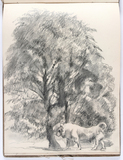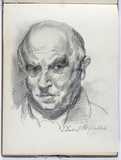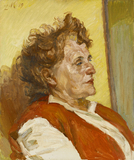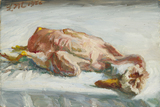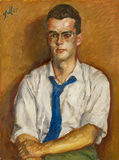Ludwig Meidner, Self-Portrait with Tallit, Kippah and Prayer Book, ca. 1964-66
Ludwig Meidner, Self-Portrait with Tallit, Kippah and Prayer Book, ca. 1964-66
The struggles are well in the past, important questions have been answered, in the arts the hatchet has been buried and I know of no better way to characterize the present than what Kohelet says in Ecclesiastes 4:6: "Better is a handful of quietness than two hands full of toil and a striving after wind."
Ludwig Meidner, "meine gehobenen Hände, ein Abendopfer" Psalm 141,2, [“and the lifting up of my hands as the evening sacrifice” Psalm 141,2] in: Ludwig Meidner. (exhibition catalogue Nassauischer Kunstverein Wiesbaden), 1959 (unpag.)
In 1963 the then head of the department of cultural affairs organized for Meidner to move into a comfortable apartment in a new building in Darmstadt. In spite of his poor health he only reluctantly allowed himself to be persuaded to give up his studio apartment in Marxheim, which was very difficult to heat and equipped only with a pit latrine in the garden. In 1964, to mark his eightieth birthday, Meidner was awarded the Federal Cross of Merit, the Villa Romana Prize and the City of Darmstadt Johann Heinrich Merck Tribute as well as being made a member of the Academy of Arts in Berlin. His work was shown in a travelling exhibition in Recklinghausen, Berlin and Darmstadt. In 1966, only a few weeks before his death, a comprehensive monograph on Meidner’s life and work was published. Nevertheless, for a long time he remained a somewhat marginal figure in art historiography. The fact that in post-war Germany he was not part of the circle of rehabilitated “degenerate” artists whose works had been included in the modernist canon – for example within the framework of the highly influential documenta 1– continued to affect his status as an artist for a long time.
This self-portrait shows Meidner wearing a prayer shawl and kippah, the head covering worn by devout Jews. The uncompleted painting, which shows its devout subject immersed in prayer, is without doubt one of the last pictures, if not the very last, that Meidner worked on.
Further reading:
Jugend und Alter. Ludwig Meidners Porträts aus den 1950er und 1960er Jahren (exhibition catalog Stadtmuseum Hofheim am Taunus), Hofheim am Taunus 2016.


